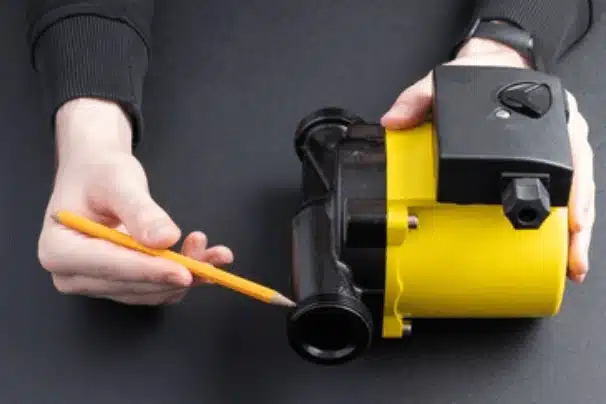Hot water is a commodity that we rely on every day for various purposes like bathing, washing dishes, and doing laundry.
However, waiting for the water to heat up can be time-consuming and wasteful.
That’s where a hot water recirculating pump comes in.
In this article, we will explore the concept of hot water recirculation and its many benefits.
A hot water recirculating pump is a device designed to provide instant hot water to faucets and showers throughout a residential or commercial building.
It eliminates the need to wait for the water to heat up, saving time, water, and energy.
Al Rooter Plumbing team provides both residential and commercial plumbing services in Houston.
Hot water recirculating pumps work by continuously circulating hot water in the plumbing system.
They are typically installed near the water heater and connected to a dedicated return line or the existing hot water line.
When the pump is activated, it moves hot water from the water heater to the fixtures.
This ensures that hot water is always available at the tap.
There are several benefits to using a hot water recirculating pump:
This can lead to significant water savings over time.
Additionally, the pump reduces energy consumption by minimizing the amount of time the water heater needs.
Yes, there are several types of hot water recirculating pumps available on the market.
Some pumps are designed for retrofit applications, while others are intended for new constructions.
Additionally, there are options for recirculation systems that utilize the existing cold water line to recirculate hot water back to the water heater.
Installing a hot water recirculating pump is a smart move for several reasons.
First, it provides instant hot water, eliminating the need to wait for the water to get hot.
Second, it saves water by recirculating hot water within the plumbing system, reducing the amount of water wasted while waiting for hot water to reach the faucet.
Third, it can be used with tankless water heaters, ensuring that hot water is always available.
Fourth, it helps deliver hot water to all faucets and fixtures by maintaining hot water circulation.
Finally, using a hot water recirculating pump can save a significant amount of money by reducing the amount of energy needed to heat the water.

A hot water recirculating pump can save water by eliminating the need to run the tap while waiting for hot water.
This can lead to significant water savings, especially in larger buildings or households with high water usage.
Yes, a hot water recirculating pump can save energy.
By reducing the time it takes for hot water to reach the faucets, it minimizes the need for the water heater to continuously heat and maintain a high temperature.
This translates into energy savings and lower utility bills.
Without a hot water recirculating pump, it typically takes several minutes for hot water to reach the faucet.
This depends on the distance between the water heater and the fixture.
This wait time can be frustrating, especially when you need hot water quickly.
Installing a hot water recirculating pump may vary depending on the specific pump model and the existing plumbing system.
While it is possible to install the pump yourself, it is recommended to hire a professional plumber.
This ensures proper installation and avoid any potential issues.

If you have some plumbing experience and the necessary tools, you might be able to install a hot water recirculating pump yourself.
However, keep in mind that there may be specific plumbing codes and regulations to follow.
Any mistakes could lead to leaks or other plumbing problems.
It’s best to consult with a professional plumber before attempting a DIY installation.
The costs of installing a hot water recirculating pump can vary depending on factors such as:
It is recommended to obtain quotes from different plumbers to get an accurate estimate for your specific situation.
Hot water recirculating pumps typically require minimal maintenance.
Regularly checking for any leaks or unusual noises, and ensuring that the pump is operating correctly, is usually sufficient.
If you notice any issues or abnormalities, it’s best to consult with a professional plumber for further inspection and maintenance.
One potential issue with hot water recirculation is the possibility of increased energy consumption.
If the recirculation system is not well-designed or if it runs continuously, it may result in higher energy costs.
It is important to properly configure the pump and controller settings to minimize energy usage.
A properly installed and maintained hot water recirculating pump should not cause any damage to your plumbing system.
However, if there are pre-existing issues or if the pump is not installed correctly, it could potentially cause leaks or other plumbing problems.
It’s essential to hire a professional plumber for installation to avoid any such issues.
While a dedicated return line is the traditional method for hot water recirculation, there are now options available that utilize the existing cold water line.
These systems:
Tankless water heaters, also known as on-demand water heaters, provide hot water instantly when needed.
They eliminate the need for a storage tank and can be a more energy-efficient option compared to traditional water heaters.
Some tankless water heater models also offer built-in recirculation systems, providing the benefits of instant hot water without requiring an additional pump.
One of the advantages of a tankless water heater recirculation pump is that it provides instant hot water.
With a tankless water heater recirculation pump, the hot water is continuously circulating within the plumbing system.
This eliminates the need to wait for the water to get hot and saves both water and energy.
The pump is typically installed near the water heater, and it works by continuously circulating the water to heat it.
This ensures that hot water is always available when needed, without the need to waste gallons of water waiting for it to get hot.
The Grundfos hot water recirculation pump is a popular choice for homeowners looking to improve their hot water circulation system.
Al Rooter Plumbing Company can solve water heaters issues including:
A demand hot water system, also known as a point-of-use system, is another alternative to a hot water recirculating pump.
It involves installing specialized devices, such as point-of-use water heaters or mini-tank water heaters, directly at the fixtures that require hot water.
These devices heat the water instantly, eliminating the need for long plumbing runs and reducing water waste.
Some other methods to get instant hot water include installing a dedicated hot water recirculation line.
This uses a storage tank with a recirculation loop, or even running the faucet continuously until the hot water reaches the desired temperature.
However, these methods may not be as efficient or convenient as using a hot water recirculating pump or alternative systems.
Solve hot water problems with our licensed and certified plumbers at Al Rooter Plumbing Company such as:

In conclusion, a hot water recirculating pump is a beneficial addition to any plumbing system.
It provides instant hot water, saves water and energy, and increases comfort and convenience.
While there are alternative solutions available, a hot water recirculating pump offers an efficient and reliable way to maximize efficiency in your home or business.
Consult with a professional plumber to determine the best option for your specific needs and enjoy the benefits of having hot water at your fingertips.
Al Rooter Plumbing team offers hot water recirculation system services
Call us at (832) 434-5936: Call us at our hotline and our customer service team will be ready to take your call.
Visit our website and fill out the contact form: Visit our website Al Rooter Plumbing Company and fill out the contact form with your information.
Email us at alrooterplumbingllc@gmail.com: You can also send us an email with your plumbing issue and we’ll get back to you as soon as possible.
| M | T | W | T | F | S | S |
|---|---|---|---|---|---|---|
| 1 | 2 | 3 | 4 | 5 | ||
| 6 | 7 | 8 | 9 | 10 | 11 | 12 |
| 13 | 14 | 15 | 16 | 17 | 18 | 19 |
| 20 | 21 | 22 | 23 | 24 | 25 | 26 |
| 27 | 28 | 29 | 30 | 31 | ||

